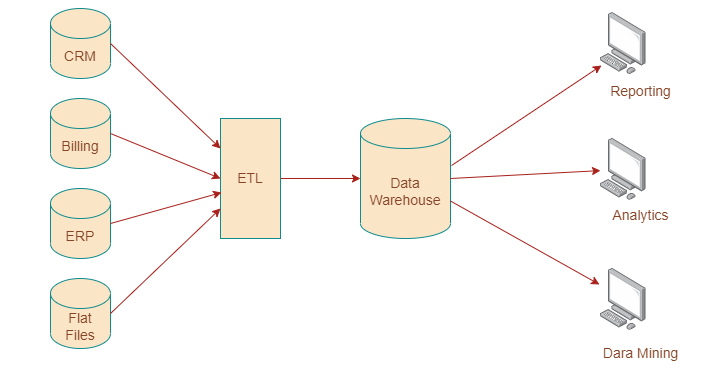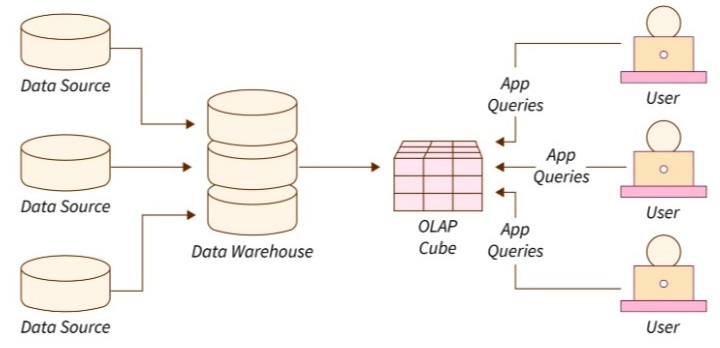
 Data Structure
Data Structure Networking
Networking RDBMS
RDBMS Operating System
Operating System Java
Java MS Excel
MS Excel iOS
iOS HTML
HTML CSS
CSS Android
Android Python
Python C Programming
C Programming C++
C++ C#
C# MongoDB
MongoDB MySQL
MySQL Javascript
Javascript PHP
PHP
- Selected Reading
- UPSC IAS Exams Notes
- Developer's Best Practices
- Questions and Answers
- Effective Resume Writing
- HR Interview Questions
- Computer Glossary
- Who is Who
Overview of Data Warehousing and OLAP
Data Warehouse
A data warehouse is like a big library where we keep a lot of information from different places. It analyzes and understands the information easily. So you can make good decisions based on these facts. You have all the required information that you need in one place. We organize the information so it's easy to find and use. It takes information from different places and put it all together in one place, hence it is easier to understand.

Characteristics of Data Warehouse
Data Warehouse has the following characteristics.
Subject-oriented
A data warehouse focuses on a specific topic like sales, marketing, or distribution. It is designed to provide information about a particular theme rather than the day-to-day operations of an organization.
Integrated
A data warehouse combines data from different sources. These sources are mainframes and relational databases, into a single, reliable format. The data must be organized and structured in a way that allows for effective analysis.
Time-variant
Data in a data warehouse is maintained over time, in weekly/monthly/annual intervals. So you can do historical analysis and the ability to track changes over time.
Non-volatile
Data in a data warehouse is permanent. Data cannot be deleted or modified once it's stored. So you can do historical analysis and ensure that the data is always available in its original state.
By understanding these characteristics, organizations can use data warehouses to make better decisions by analyzing large amounts of data from different sources in a consistent and reliable way.
Data warehousing has some advantages and disadvantages.
Advantages
Makes data easier to understand
Continuous updating
Accessibility
Disadvantages
Accumulation of irrelevant data
Data loss and erasure
Data cleansing and transformation
Functions of Data warehouse
A data warehouse is a collection of data that is organized to provide various functions for managing and analyzing data. Some of the important functions of a data warehouse are ?
Data Consolidation
Data Cleaning
Data Integration
Data Storage
Data Transformation
Data Analysis
Data Reporting
Data Mining
Performance Optimization
These functions enable organizations to manage and analyze large amounts of data from different sources, and make informed decisions based on reliable and accurate information.
Online Analytical Processing Server (OLAP)
Online Analytical Processing Server (OLAP) is a software. Users can analyze information from many different databases all at once. It uses a multidimensional data model where users can ask questions based on multiple dimensions at the same time. For example, a user could ask for sales data from Delhi in the year 2018. OLAP databases are split up into cubes, which are also called hyper-cubes.

OLAP operations
These are used to analyze data in an OLAP cube. There are five basic operations:
Drill down
This makes the data more detailed by moving down the concept hierarchy or adding a new dimension. For example, in a cube showing sales data by Quarter, drilling down would show sales data by Month.
Roll up
This makes the data less detailed by climbing up the concept hierarchy or reducing dimensions. For example, in a cube showing sales data by City, rolling up would show sales data by Country.
Dice
This selects a sub-cube by choosing two or more dimensions and criteria. For example, in a cube showing sales data by Location, Time, and Item, dicing could select sales data for Delhi or Kolkata, in Q1 or Q2, for Cars or Buses.
Slice
This selects a single dimension and creates a new sub-cube. For example, in a cube showing sales data by Location, Time, and Item, slicing by Time would create a new sub-cube showing sales data for Q1.
Pivot
This rotates the current view to get a new representation. For example, after slicing by Time, pivoting could show the same data but with Location and Item as rows instead of columns
Comparison between Data Warehousing and OLAP
Feature |
Data Warehousing |
OLAP |
|---|---|---|
Definition |
A process of collecting, storing, and managing data from various sources to provide meaningful business insights |
A technology that allows users to analyze information from multiple database systems at the same time based on the multi-dimensional data model |
Purpose |
To make data accessible and understandable for business users |
To provide quick and interactive analysis of data from multiple sources |
Data structure |
Relational database |
Multidimensional data model |
Data source |
Multiple data sources |
Multiple data sources |
Data type |
Historical data |
Current and historical data |
Data processing |
Batch processing |
Real-time processing |
Operations |
Data cleaning, consolidation, integration, transformation, analysis, and reporting |
Drill-down, roll-up, slice, dice, and pivot |
Cube creation |
Not applicable |
Cubes are created to support fast and efficient analysis |
Query performance |
Slower query performance due to complex querying and data processing |
Faster query performance due to pre-aggregation and indexing |
User type |
Business users and data analysts |
Business users and data analysts |
Use case |
Decision-making and strategic planning |
Real-time analysis and interactive reporting |
Conclusion
In conclusion, both data warehousing and OLAP serve different purposes in managing and analyzing data. Data warehousing focuses on collecting and organizing data from various sources into a single, reliable format to provide historical insights for decision-making and strategic planning. On the other hand, OLAP allows for quick and interactive analysis of current and historical data from multiple database systems based on a multidimensional data model. OLAP uses operations such as drill-down, roll-up, slice, dice, and pivot to analyze data efficiently. While data warehousing may have slower query performance due to complex querying and data processing, OLAP offers faster query performance due to pre-aggregation and indexing. Both technologies are beneficial for business users and data analysts in making informed decisions based on reliable and accurate information.

